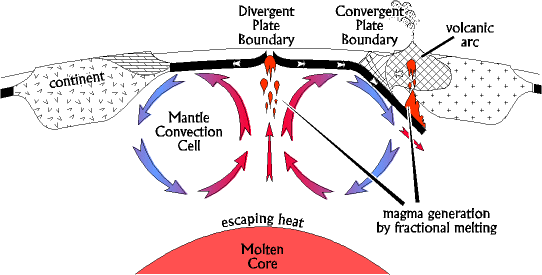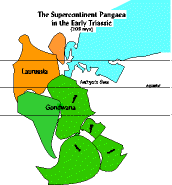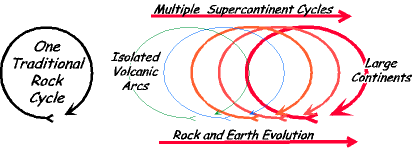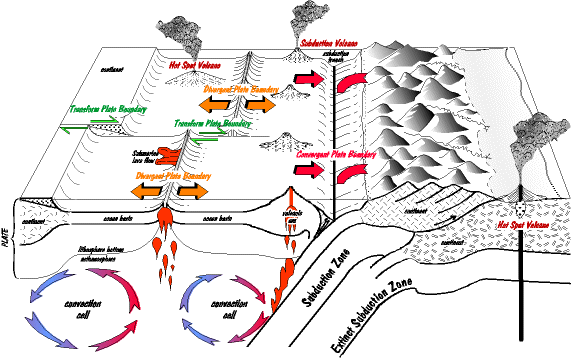SYNOPSIS OF PLATE TECTONIC THEORY
And Its Implications for Earth History
Plate tectonics is the theory that the outer rigid layer of the earth (the lithosphere) is divided into about a dozen " plates" that move across the earth's surface relative to each other, like slabs of ice on a lake (click picture below for a larger version).And Its Implications for Earth History
The movement of the plates is driven by convection cells in the mantle so the plates are continuously jostling against each other. Geologically, the most important things happen at plate boundaries, including most of the earthquakes, volcanos, igneous rocks, major metamorphism, and mountain building processes. Interplate regions tend to be rather boring.
There are three kinds of plate boundaries. Divergent boundaries are where plates separate from each other, and magma oozes up from the mantle into the crack (a fissure volcano) making the ocean basin wider. This is known as sea floor spreading.
Convergent boundaries are where plates come together, but to do so one of the plates must dive below the surface into the mantle along a subduction zone. Convergent boundaries produce mountain chains of very large, explosive volcanos (composite type).
And, transform boundaries where plates slide past each other, ideally with little or no vertical movement. Most transform boundaries are below sea level and so not easy to see. The San Andreas fault in California is a transform boundary.
PLATE TECTONICS AND THE EARTH'S EVOLUTION
Aside from all the details of plate tectonic theory (explored below) a couple of significant concepts come from plate tectonic theory. One of these is that plate tectonic processes have led to the evolution of the earth. When the earth originated it contained no continents, and consisted of only a few kinds of igneous rock - roughly the composition of the moon. But through plate tectonic processes the earth has evolved first to form volcanic island chains (volcanic arcs scattered across a single world wide ocean), and then for these to enlarge to form the large continental masses we live on today.These evolutionary processes take place because igneous rocks evolve at convergent and divergent plate boundaries. At both places magma is generated, and through processes of fractional melting (partial melting) whole new rocks are created including those that form continental masses.

A second significant idea derived from plate tectonic theory is that as the continents have grown through time they have alternately come together to form supercontinents, only to fragment again to form smaller isolated continents.
 The last supercontinent was Pangaea that formed about 300 million years ago when the isolated continents collided. During its existence only the one large continent existed, balanced by one large ocean, Panthalassa. During the fragmentation stage (beginning about 230 million years ago and still going on) the present Atlantic ocean opened up, and all the continents are now scattering across the globe.
The last supercontinent was Pangaea that formed about 300 million years ago when the isolated continents collided. During its existence only the one large continent existed, balanced by one large ocean, Panthalassa. During the fragmentation stage (beginning about 230 million years ago and still going on) the present Atlantic ocean opened up, and all the continents are now scattering across the globe.But, prior to Pangaea another supercontinent called Rodinia existed about 600 million years ago. It also formed from the accumulation of isolated continents, only to fragment shortly after its formation. And before that there were other supercontinents.
Simplistically, we can think about it this way. The present day Atlantic ocean is getting wider because of sea floor spreading. But since the earth is spherical that means things must be coming together some place else, and that is in the Pacific ocean. The Pacific ocean is getting smaller along subduction zones (convergent plate boundaries) under North and South America, and Japan, as western North America and Asia get closer together. Sometime in the future the Pacific ocean will close completely and Asia and North America will collide to form another supercontinent.
The history of Gondwana and Rodinia tell us that this supercontinent will not stay together long either, and will fragment into isolated continents scattered across the earth again.
THE SUPERCONTINENT CYCLE
So, we can imagine the earth's history as a supercontinent cycle. The cycle begins with a supercontinent perched on one side of the earth, balanced on the other side by a superocean. The supercontinent fragments, sending small continental pieces across the ocean to collide to form another supercontinent on the opposite side of the earth. But, shortly that supercontinent fragments also to repeat the cycle. And this has been going on for 4 billion years, requiring about half a billion years for each cycle.This supercontinent cycle does not just go round and round, however, for with each cycle new continental crust is generated, and the continents get bigger. The earth's history is not just a cycle that goes round and round without getting anywhere. Rather, it is a cycle with a directional and irreversible evolutionary trend.

Simplistically, we can imagine this as a globe, and we are passing our hands (the continents) east and west around to one side to collide them. And then separating (fragmenting the continents) and bringing them back around to the other side to collide them again. By swinging our hands back and forth around this imaginary globe in front of us we can envision the oscillating cycle of the continents.
There is just one caution. Because the earth is spherical, actual continental movements are quite complex because continents do not just move east and west, they also move north and south, as well as various combinations of these movements. And continents do not always fragment and collide the same way with each cycle. So, it is not really as simple as swinging our hands around an imaginary globe in front of us. We must be careful in our development of simple models that we do not include significant distortion too.
A HISTORY
 So, there is a history here, the earth beginning with only oceans, . . .
So, there is a history here, the earth beginning with only oceans, . . .  has evolved its continents beginning 4 billion years ago with small volcanic chains (arcs), created by convection cells and subduction zones, . . .
has evolved its continents beginning 4 billion years ago with small volcanic chains (arcs), created by convection cells and subduction zones, . . .
 that evolved into proto-continents through many individual subduction zones, . . .
that evolved into proto-continents through many individual subduction zones, . . .
 that evolved into micro-continents when the proto-continents collided, . . .
that evolved into micro-continents when the proto-continents collided, . . . that evolved into the major continents today (such as North and South America, Siberia, Australia), that continue to evolutionarily cycle through supercontinent cycles (e.g. Pangaea and Rodinia, but also earlier supercontinent cycles).

This is a wonderful story of great grandeur. The planet we live on is marvelous beyond description. Our goal has to be to transmit to each generation not just the details of identifying rocks, but the wonder of a planet that lives, and grows, and evolves - and is never quiet, for to be quiet would be to die.
Go On To:
